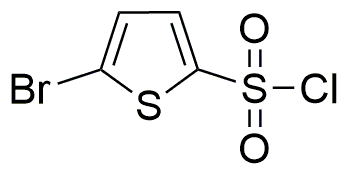5-Bromo-2-thiophenesulfonyl chloride is widely utilized in research focused on:
- Synthetic Chemistry: This compound serves as a key intermediate in the synthesis of various pharmaceuticals and agrochemicals, facilitating the development of new drugs and crop protection agents.
- Material Science: It is employed in the production of advanced materials, particularly in creating conductive polymers and organic semiconductors, which are essential for electronic devices.
- Bioconjugation: The chemical is used for labeling biomolecules, aiding in the development of targeted drug delivery systems and diagnostic tools in biomedical research.
- Organic Synthesis: It acts as a sulfonylating agent, allowing chemists to introduce sulfonyl groups into organic compounds, which can enhance their biological activity and solubility.
- Research and Development: This compound is valuable in academic and industrial laboratories for exploring new chemical reactions and mechanisms, contributing to the advancement of chemical knowledge.
General Information
Properties
Safety and Regulations
Applications
5-Bromo-2-thiophenesulfonyl chloride is widely utilized in research focused on:
- Synthetic Chemistry: This compound serves as a key intermediate in the synthesis of various pharmaceuticals and agrochemicals, facilitating the development of new drugs and crop protection agents.
- Material Science: It is employed in the production of advanced materials, particularly in creating conductive polymers and organic semiconductors, which are essential for electronic devices.
- Bioconjugation: The chemical is used for labeling biomolecules, aiding in the development of targeted drug delivery systems and diagnostic tools in biomedical research.
- Organic Synthesis: It acts as a sulfonylating agent, allowing chemists to introduce sulfonyl groups into organic compounds, which can enhance their biological activity and solubility.
- Research and Development: This compound is valuable in academic and industrial laboratories for exploring new chemical reactions and mechanisms, contributing to the advancement of chemical knowledge.
Documents
Safety Data Sheets (SDS)
The SDS provides comprehensive safety information on handling, storage, and disposal of the product.
Product Specification (PS)
The PS provides a comprehensive breakdown of the product’s properties, including chemical composition, physical state, purity, and storage requirements. It also details acceptable quality ranges and the product's intended applications.
Certificates of Analysis (COA)
Search for Certificates of Analysis (COA) by entering the products Lot Number. Lot and Batch Numbers can be found on a product’s label following the words ‘Lot’ or ‘Batch’.
*Catalog Number
*Lot Number
Certificates Of Origin (COO)
This COO confirms the country where the product was manufactured, and also details the materials and components used in it and whether it is derived from natural, synthetic, or other specific sources. This certificate may be required for customs, trade, and regulatory compliance.
*Catalog Number
*Lot Number
Safety Data Sheets (SDS)
The SDS provides comprehensive safety information on handling, storage, and disposal of the product.
DownloadProduct Specification (PS)
The PS provides a comprehensive breakdown of the product’s properties, including chemical composition, physical state, purity, and storage requirements. It also details acceptable quality ranges and the product's intended applications.
DownloadCertificates of Analysis (COA)
Search for Certificates of Analysis (COA) by entering the products Lot Number. Lot and Batch Numbers can be found on a product’s label following the words ‘Lot’ or ‘Batch’.
*Catalog Number
*Lot Number
Certificates Of Origin (COO)
This COO confirms the country where the product was manufactured, and also details the materials and components used in it and whether it is derived from natural, synthetic, or other specific sources. This certificate may be required for customs, trade, and regulatory compliance.


